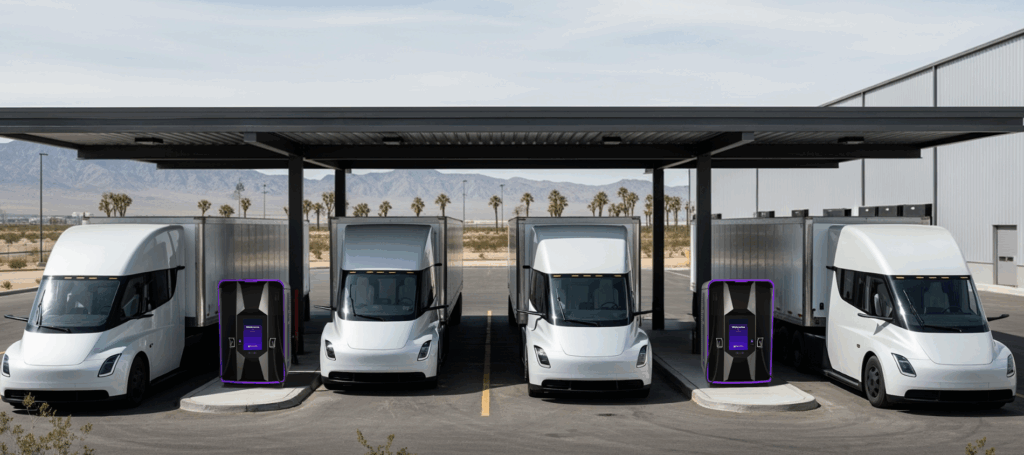Electrifying Eastern Market

Detroit’s Eastern Market is working to become a national model for integrating freight solutions that reduce fossil fuel use and freight operation costs. San Carlos, Calif.-based ElectricFish, a finalist in the Toyota Mobility Foundation’s Sustainable Cities Challenge, was chosen to build battery-integrated fast chargers to power EVs and provide backup energy for Eastern Market. As one of only three cities worldwide chosen for this challenge, Detroit is using the opportunity to position itself as a leader in transportation innovation, this time in clean mobility. SBN Detroit interviewed ElectricFish co-founder Anurag Kamal about why Eastern Market is the ideal proving ground, what this means for the city’s EV landscape, and how this project could influence urban electrification nationwide. Q: What does Detroit’s selection as a Toyota Mobility Foundation Sustainable Cities Challenge finalist mean for its position in EV and clean mobility? A: Being one of just three cities in the world chosen for this program is an achievement in itself. Detroit has always been a center of automotive innovation, and now we’re seeing a new evolution – from internal combustion to electric. The challenges are complex, especially for medium- and heavy-duty freight vehicles, where electrification requires both cost-effective solutions and robust infrastructure. This project is a way to demonstrate what’s possible and draw attention to Detroit’s potential in leading the shift to sustainable transport. Q: What advantages or challenges does Detroit present for innovating in EV infrastructure? A: Detroit’s biggest advantage is its proximity to the automakers and decision-makers. For startups like ours, having industry leaders see our work firsthand is invaluable. But Detroit is also a challenging test bed – the infrastructure in many areas is outdated and upgrading it can be extremely expensive. In places like Eastern Market, where we’re deploying, the cost to modernize could run into the millions. That’s why we’re proving there’s a different, more cost-effective way to build charging capability that can be replicated in other cities with similar constraints. Q: How does the Toyota Mobility Foundation competition help accelerate innovation? A: Funding is a huge part of it. Detroit secured $3 million for the first phase, with additional funding for companies that advance to later stages. Just as important is the collaboration—talking directly with local businesses, understanding their needs, and identifying unique challenges. For example, a mid-sized fishery in Eastern Market could lose thousands of dollars in product during a four- to six-hour outage caused by infrastructure upgrades. Backup energy solutions become not just a convenience, but a necessity. Q: What does success look like for this project? A: In the short term, success means mid-sized businesses in Eastern Market integrating sustainable practices, whether that’s switching to EVs or having accessible charging infrastructure on-site. For small vendors, it means being able to plug in while working in the market. On September 26, we will launch the first Public Fast Charging Hub at an event that’s open to the public. We’ll be able to demonstrate first-hand how businesses can benefit, and we are hoping to get early adoption. Long term, we want Detroit’s project to be a national case study in rapid, cost-effective urban electrification—something that inspires other cities to follow. Q: What are the biggest gaps you see today in EV charging and fleet electrification? A: Infrastructure is the number one gap. There’s a common perception that switching to electric means changing your entire workflow, parking a vehicle overnight for charging, waiting hours instead of minutes. That’s not sustainable for many businesses. The challenge is not just funding infrastructure but also developing alternative technologies and deployment models that make charging fast, flexible, and accessible. Q: As a startup, how do you decide which innovations to prioritize? A: It’s a constant balancing act. We designed a product with two very fast charging ports that can be deployed almost anywhere. But some customers question the need to pay for faster charging when they don’t see the immediate benefit. Others, like Amazon, request larger-scale systems with eight ports. The key is to stay laser-focused on our mission, move quickly, and avoid overextending into too many variations at once. Q: What lessons have you learned about scaling technology in a rapidly changing industry? A: Flexibility is everything. We’ve seen battery pack prices drop from $200,000 to $60,000 in just three and a half years. Locking into long-term agreements without room to adapt can be costly. We make sure our supply agreements account for technological changes, so we can pivot as new, more cost-effective options emerge. Q: What’s your vision for Detroit’s EV charging landscape in 10 years? A: I think we’ll see significant fleet electrification – possibly 10% adoption or more – along with widespread public and private charging. Places that sell fuel today will likely also serve EV drivers. Home charging will be common for homeowners, but public infrastructure will carry the bulk of the load. If projects like Eastern Market succeed, Detroit could be one of the most compelling examples of how urban EV infrastructure can be built quickly, effectively, and in a way that meets the needs of diverse users. Be sure to subscribe to our newsletter for regular updates on sustainable business practices in and around Detroit.


